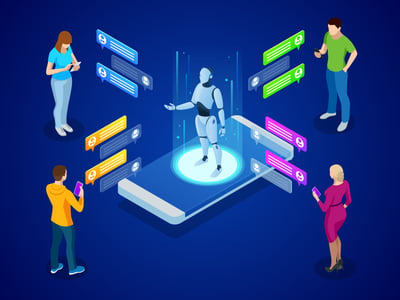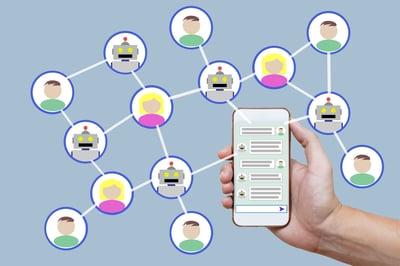February 12, 2020
 by Adela Belin / February 12, 2020
by Adela Belin / February 12, 2020
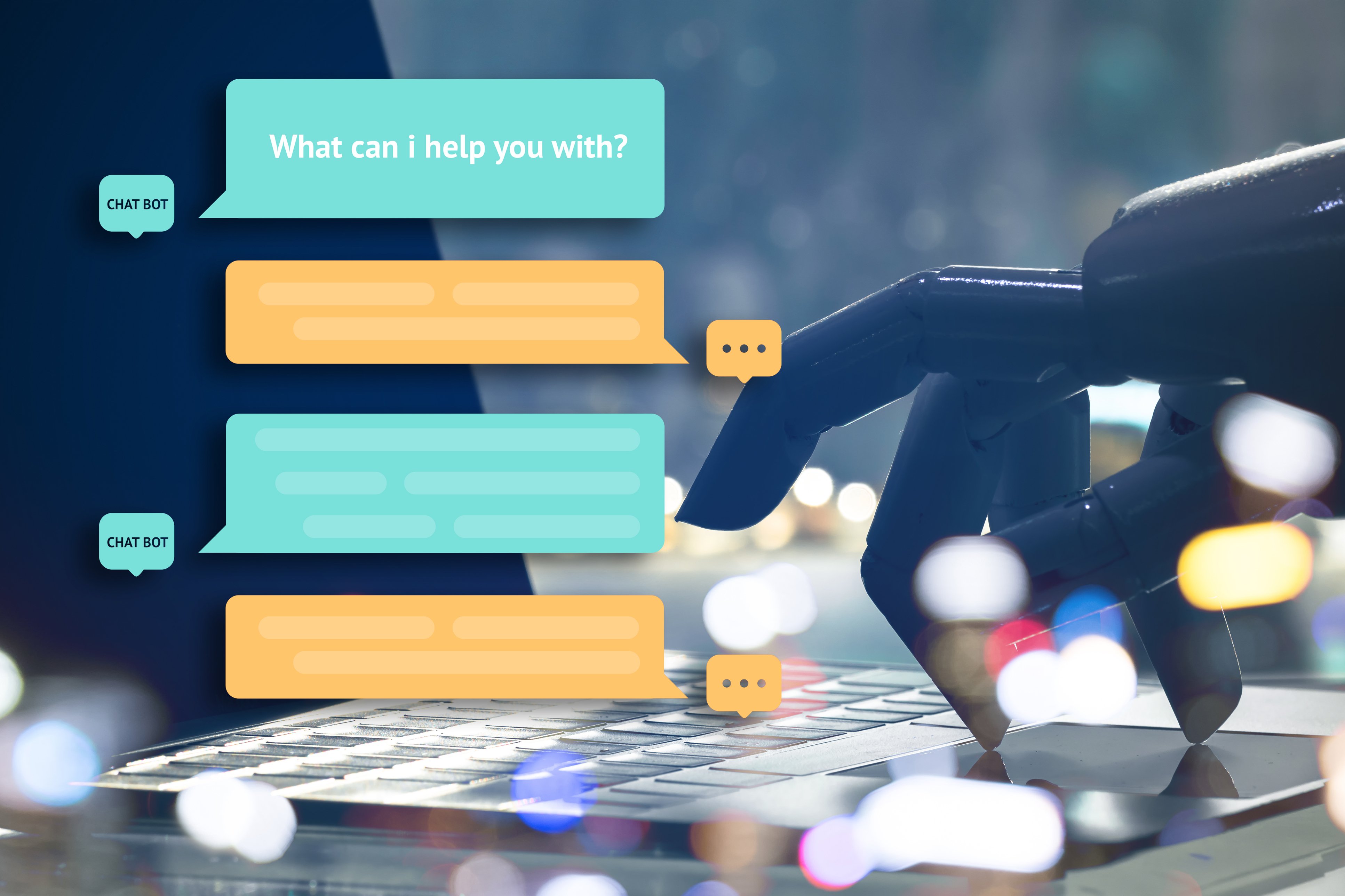
From helping people book their flight tickets or presenting them with shopping suggestions online, chatbots are everywhere.
Chatbots are increasingly being used to engage customers, deliver useful content, influence purchase decisions and enhance customer service.
The good news is that consumers are open to this change. Thirty-five percent of consumers want to see more companies using chatbots. However, as much as chatbots are revolutionizing the way people interact with brands, the truth is that no one enjoys speaking to a machine. It’s frustrating when customers have to repeat themselves or when they’re met with unhelpful, template-like answers.
So, how do you build a chatbot without making it sound like a machine? Let's find out.
Let’s take a look at seven effective ways to make your chatbot sound human and deliver a personalized experience.
What seems more welcoming: a chatbot titled BOT, or one named ‘Paul’ with an actual picture? Clearly the latter.
Giving your chatbot a human name and face is the first step toward making it sound like a real person. It’s easier for people to get familiar with the chatbot and trust it to resolve their issues when it’s coming from one that’s human-like.
Apart from giving it a name and face, it’s also advisable to chalk out personality traits for your chatbot that are in line with your target audience’s expectations. For instance, is your chatbot a man, woman, or is it gender-neutral? Is it chatty or formal? Is it enthusiastic or matter-of-fact? Is it irreverent or respectful?
Knowing the answers to these questions sets the foundation for the script and conversation. So, give your chatbot a name, face, and personality so your customers feel like they’re speaking to a human.
Here’s an example of Amtrak’s chatbot named Julie, posing a human name and face.
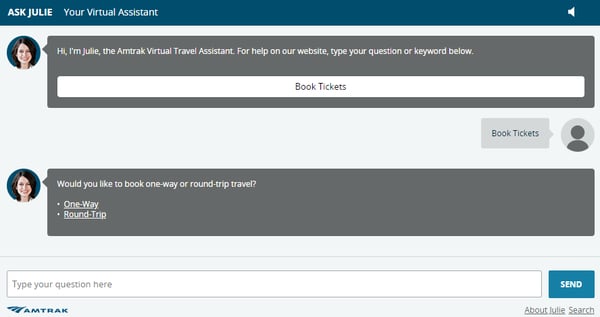
Conversational marketing has grown to become an effective tool to attract, delight and engage customers. Gone are the days when a promotional piece of content or advertisement would hold the same influential power it once did.
Today, it’s all about having a two-way conversation, personalizing responses and giving instant solutions, which makes creating a powerful, value-driven chatbot conversation strategy extremely important.
The first step is to develop a conversation flow. Conversation flow is a flow diagram that constitutes all the possible scenarios the chatbot can be met with and the corresponding outcomes. This needs to be developed keeping the user journey in mind and the kind of experience you want to deliver.
Once you have the conversation flow ready, you can get creative and work on the script. Remember to keep conversations short and succinct to avoid overwhelming the user with blocks of text.
Context forms an essential part of our everyday conversations, so why shouldn’t the same reflect in chatbot conversations? There is nothing more annoying for a customer than to not be understood.
Here’s an example. A buyer is looking for espadrilles on a fashion e-commerce website. She is unable to remember what they’re called, and ends up explaining what they look like instead of using the word ‘espadrilles’. This can result in a harrowing customer experience if the chatbot is only designed to identify keywords.
To prevent miscommunication, while developing a chatbot, it’s important to incorporate context to ensure it detects user intent. That’s what makes it engaging, helpful, and relevant.
An effective way to achieve that is by asking questions to understand the customer rather than urging them to make a purchase or asking them for their email id and leaving it at that. When you ask questions and gather information, you’re able to offer solutions and create a more contextual customer experience.
Imagine using a chatbot to order groceries and having to repeat your address and number every time you use it. Tiresome, isn’t it?
One of the biggest advantages of a chatbot is that it helps you enhance customer service but how many companies are using this feature and making data for work for them? Not too many.
Maintaining a repository of the right customer details and leveraging them during customer interactions helps deliver a personalized user experience.
That’s not all, though. Chatbots can also be programmed to track product pages visited, website behavior, search terms, past chatbot conversations, and buying behavior to put together insights that can add value to conversations. Integrating the two will help you know your customers better, create relevant content and offer quick solutions.
You land on a website, a chatbot pops up with a GIF of someone waving - it instantly catches your attention and makes you want to engage with it.
This is exactly why it’s a good idea to use GIFs, images, emojis, videos and other types of multimedia content in chatbot conversations. Not only do they humanize your chatbot, but they are also a fun way to express emotions and make for a more relatable and casual conversation.
When you’re incorporating rich content, make sure it’s line with your bot’s personality and the message you’re trying to communicate is crystal clear.
That said, don’t make the mistake of over-doing it because that can get annoying and defeat the purpose. You can consider using rich media when you’re trying to break up long blocks of text or replace generic statements or reactions (e.g. greeting message, haha, wow, etc.).
Here’s an example of Monty, G2’s bot. Notice how it casually inserts a GIF in the conversation, as a greeting?
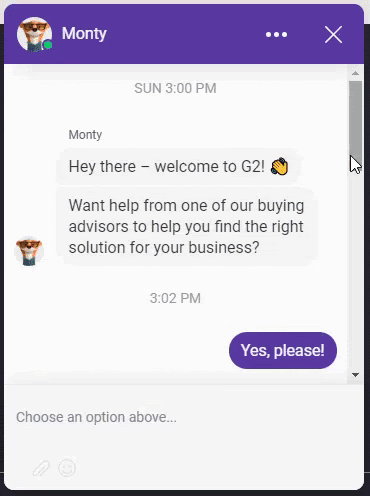
Adding humor is always tricky because it’s subjective; what’s hilarious to one person might be offensive to another.
However, when you’re looking to make your chatbot sound human, humor is certainly an element you can play around with. It adds to your bot’s personality and helps build relationships. The trick is to strike a balance between using humor appropriately in line with the context and sentiment of the users and not have it offend them.
A great place to use humor is when you’re trying to break the ice because a witty or comical message does manage to grab people’s attention and reels them in to engage. Another place humor works is when you’re trying to cover up a mistake as it’s an effective way to lighten the situation and ease matters.
Adding humor also hugely depends on the kind of brand you are. For instance, a weather bot can inject humor but you'd rather not have a hospital chatbot be "funny". An example of a bot that does this well is Woebot, an online psychologist chatbot developed by a clinical psychologist.
Natural language processing (NLP) is a tool to help computers understand, interpret and derive meaning from natural, human language. The idea behind NLP is to bridge the gap between human and computer communication.
Adding NLP humanizes your chatbot and improves chatbot performance. NLP does not just identify keywords, it enables chatbots to understand the intent of the user’s message so they’re able to give a tailored response.
How does NLP work? Once the chatbot receives a request, it analyzes it as per the algorithm, identifies intent and entities and composes a suitable reply.
For example, if you type, “what’s the weather in Spain tomorrow,” your intent is to get weather information and the entities are ‘Spain’ and ‘tomorrow’. NLP is a highly beneficial investment as it leads to increased customer satisfaction and elevates their experience.
As a company incorporates a chatbot, it’s important to go the extra mile and take efforts to make your chatbot sound human. Customers want to be heard and understood which is only possible when they’re speaking to a chatbot that responds the way a human would.
Your chatbot is the voice of your brand and it needs to deliver a personalized experience that delights customers. Remember: chatbots are a machine, but they don’t have to sound like one.
Start using chatbot software as a part of your website and online marketplace strategy today! Find all available solutions on G2.
Adela Belin is a content marketer and blogger at Writers Per Hour. She is passionate about sharing stories with the hope to make a difference in people's lives and contribute to their personal and professional growth.
Have you encountered a chatbot in place of a human customer service representative (CSR) on a...
 by Rebecca Reynoso
by Rebecca Reynoso
With the popularity of online shopping and regular growth of the e-commerce market, demand for...
 by Rebecca Reynoso
by Rebecca Reynoso
The use of chatbot technology has risen throughout the 2010s, yet as early as the 1960s,...
 by Rebecca Reynoso
by Rebecca Reynoso
Have you encountered a chatbot in place of a human customer service representative (CSR) on a...
 by Rebecca Reynoso
by Rebecca Reynoso
With the popularity of online shopping and regular growth of the e-commerce market, demand for...
 by Rebecca Reynoso
by Rebecca Reynoso

